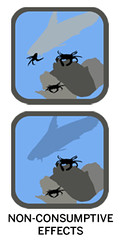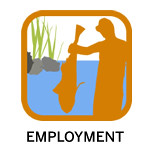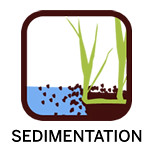Dr. Randall Hughes FSU Coastal & Marine Lab
If you’re a regular reader of the blog, you’ll realize that we often talk about similar research questions or ideas in the context of different projects. As David mentioned in his description of the Baymouth Bar project, this overlap is usually intentional: as ecologists, we’re interested not only in the specific habitats that we study, but also in the underlying factors that affect these habitats and the valuable services that they provide to we humans.
It may appear at times that we’ve been covering a diverse array of topics, and while this is true, all of these topics are interconnected- a web of topics centered around a couple of central themes. The diagram below is the map that shows where every post-topic fits into these central themes. Even the artists, writers, and photographers we occasionally feature have their place amongst ecological processes like sedimentation and the non-consumptive effects of predators. Every post from here on out will have one of these icons on it- if you don’t know what the icon means, just click on it and you’ll be back at this figure with an explanation:
So what concepts do they illustrate?
 (1) How do “top predators” (here, large fish and crabs, conveniently located at the top of the figure) affect “intermediate consumers” (small crabs and snails), and how do these effects of predation influence the “basal species” (oysters or salt marsh plants)? We’ve divided things so that oyster reefs are illustrated on the left and salt marshes on the right, but as you may have noticed, many of the important species in these habitats (think blue crabs or crown conchs) are actually the same, and sometimes the habitats occur adjacent to each other as depicted here. This chip condenses the action on the oyster reef side of the central diagram, to make it easier to fit onto individual posts.
(1) How do “top predators” (here, large fish and crabs, conveniently located at the top of the figure) affect “intermediate consumers” (small crabs and snails), and how do these effects of predation influence the “basal species” (oysters or salt marsh plants)? We’ve divided things so that oyster reefs are illustrated on the left and salt marshes on the right, but as you may have noticed, many of the important species in these habitats (think blue crabs or crown conchs) are actually the same, and sometimes the habitats occur adjacent to each other as depicted here. This chip condenses the action on the oyster reef side of the central diagram, to make it easier to fit onto individual posts.
 (2) Are effects of predation due to top predators eating their prey (dark arrows) or due to top predators scaring their prey (light arrows)? This idea of consumptive (eating) and non-consumptive (scaring) effects of predators is also illustrated by the 2 icons at the left (which will be the images placed on posts) – in one, a fish is actually eating a mud crab on the reef; in the other, the presence of the fish alone can cause the crabs to behave differently.
(2) Are effects of predation due to top predators eating their prey (dark arrows) or due to top predators scaring their prey (light arrows)? This idea of consumptive (eating) and non-consumptive (scaring) effects of predators is also illustrated by the 2 icons at the left (which will be the images placed on posts) – in one, a fish is actually eating a mud crab on the reef; in the other, the presence of the fish alone can cause the crabs to behave differently.
(3) How do these effects of top predators and intermediate consumers affect the ecosystem services that we rely on from these habitats? Here we focus on services specific to oyster reefs:
As well as those common to reefs and marshes (and seagrasses):
 f. Providing a livelihood for commercial fishermen, people who work in ecotourism (like kayak guides), seafood restauranteurs and their employees- not to mention researchers and nature documentarians! This chip will show up on posts dealing with the job of being a researcher, grad student, lab tech, etc.
f. Providing a livelihood for commercial fishermen, people who work in ecotourism (like kayak guides), seafood restauranteurs and their employees- not to mention researchers and nature documentarians! This chip will show up on posts dealing with the job of being a researcher, grad student, lab tech, etc.It’s important to note that these are just a subset of the many services that these habitats provide; we’ve selected them because they are the ones most often investigated in our research and/or discussed here on the blog.
 (4) What are the effects of species or genetic diversity on predator-prey interactions or ecosystem services? We know that marshes and reefs differ in the number of plant species, or the number of fishes and crabs, and so much of our work examines how these differences affect the quality and productivity of the habitat.
(4) What are the effects of species or genetic diversity on predator-prey interactions or ecosystem services? We know that marshes and reefs differ in the number of plant species, or the number of fishes and crabs, and so much of our work examines how these differences affect the quality and productivity of the habitat.
 (5) How do all of the ecological processes that we’re interested in change as you travel from one area to another, whether it is 1 mile or 100 miles? There are two reasons why it is important to test things in more than 1 location. First, we want to learn how consistent our results are – if something happens in 1 place but not in another, then it may not be relevant to the big picture of how these systems work. And second, we want to be able to make some predictions about how our results may apply under other conditions. By taking advantage of natural changes in tidal patterns in the Gulf of Mexico, or temperature as you move up the Atlantic coast, we can increase the generality of our findings.
(5) How do all of the ecological processes that we’re interested in change as you travel from one area to another, whether it is 1 mile or 100 miles? There are two reasons why it is important to test things in more than 1 location. First, we want to learn how consistent our results are – if something happens in 1 place but not in another, then it may not be relevant to the big picture of how these systems work. And second, we want to be able to make some predictions about how our results may apply under other conditions. By taking advantage of natural changes in tidal patterns in the Gulf of Mexico, or temperature as you move up the Atlantic coast, we can increase the generality of our findings.
Each post that we do from now on will have 1 or more of these icons at the top that will link you back to where that post fits within this broader picture. We hope that these icons will draw your attention to the over-arching goals of our research and the interesting commonalities between In the Grass and On the Reef. Plus we hope you think they look nice!







2 comments
Dear Randall and Rob,
Nice blog. I love the graphics, especially the inclusion of biodiversity, geography, economy and services to us humans. It is this interconnection that is not often explicit. Keep up the good work!
Thank you Randall for making it more explicit for us armchair marine biologists. The graphic really helped me understand the relationships! I will be following with interest!
Comments are closed.